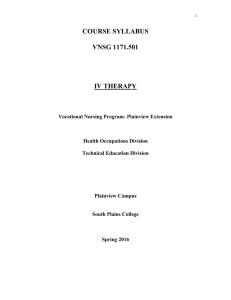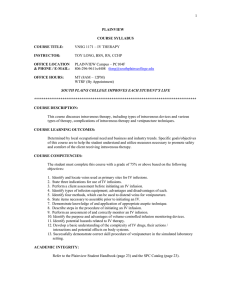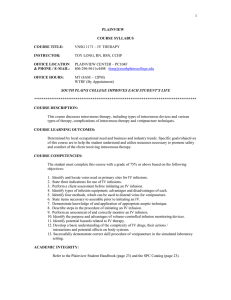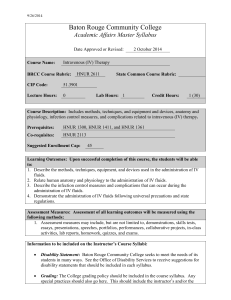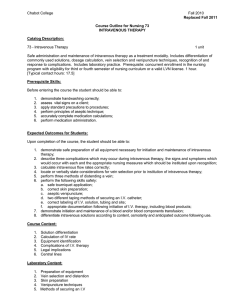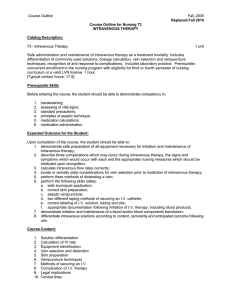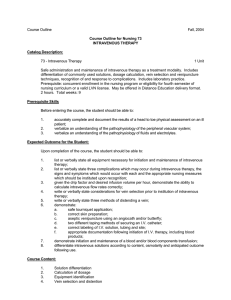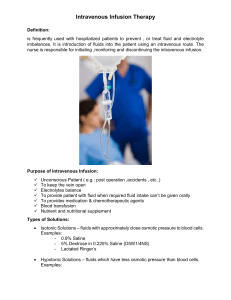COURSE SYLLABUS VNSG 1171.501 IV THERAPY
advertisement
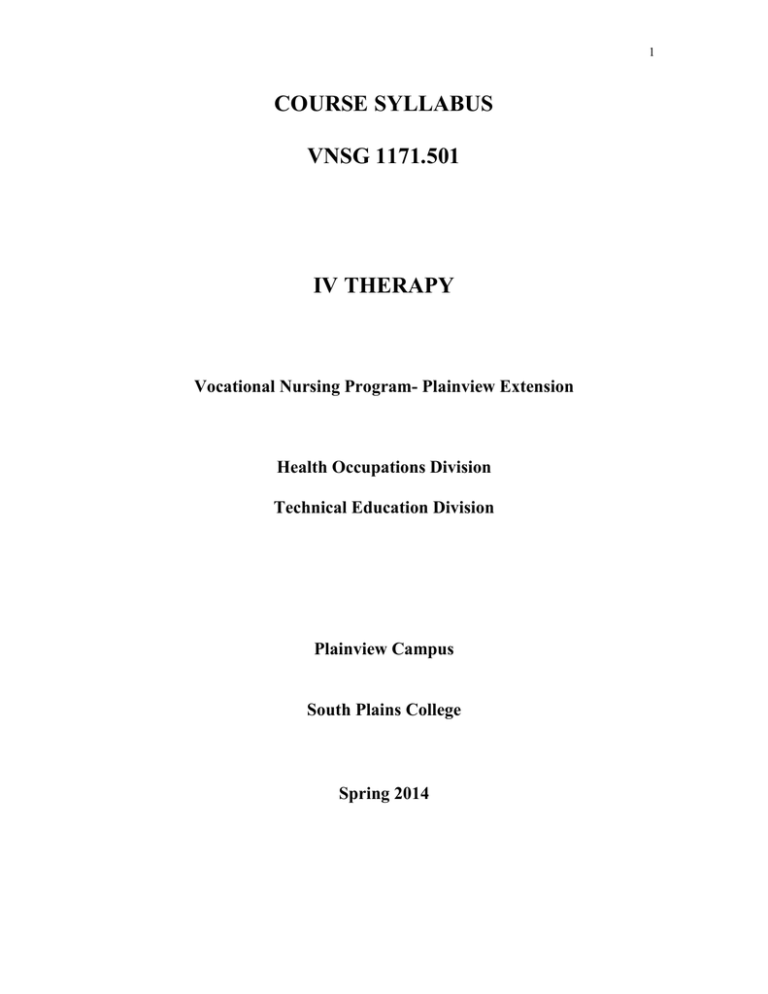
1 COURSE SYLLABUS VNSG 1171.501 IV THERAPY Vocational Nursing Program- Plainview Extension Health Occupations Division Technical Education Division Plainview Campus South Plains College Spring 2014 2 PLAINVIEW COURSE SYLLABUS COURSE TITLE: VNSG 1171 – IV THERAPY INSTRUCTOR: TOY LONG, BSN, RN, CCHP 3 OFFICE LOCATION & PHONE / E-MAIL: PLAINVIEW Campus – PC104F 806-296-9611x4408 tlong@southplainscollege.edu OFFICE HOURS: Mon. (8AM – 12PM) TWTRF (By Appointment) SOUTH PLAINS COLLEGE IMPROVES EACH STUDENT’S LIFE ************************************************************************************** COURSE DESCRIPTION: This course discusses intravenous therapy, including types of intravenous devices and various types of therapy, complications of intravenous therapy and venipuncture techniques. COURSE LEARNING OUTCOMES: Determined by local occupational need and business and industry trends. Specific goals/objectives of this course are to help the student understand and utilize measures necessary to promote safety and comfort of the client receiving intravenous therapy. COURSE COMPETENCIES: The student must complete this course with a grade of 75% or above based on the following objectives: 1. Identify and locate veins used as primary sites for IV infusions. 2. State three indications for use of IV infusions. 3. Perform a client assessment before initiating an IV infusion. 4. Identify types of infusion equipment; advantages and disadvantages of each. 5. Identify four methods, which can be used to distend veins for venipuncture. 6. State items necessary to assemble prior to initiating an IV. 7. Demonstrate knowledge of and application of appropriate aseptic technique. 8. Describe steps in the procedure of initiating an IV infusion. 9. Perform an assessment of and correctly monitor an IV infusion. 10. Identify the purpose and advantages of volume-controlled infusion monitoring devices. 11. Identify potential hazards related to IV therapy. 12. Develop a basic understanding of the complexity of IV drugs, their actions / interactions and potential effects on body systems. 13. Successfully demonstrate correct skill procedure of venipuncture in the simulated laboratory setting. ACADEMIC INTEGRITY: Refer to the Plainview Student Handbook (page 23) and the SPC Catalog (page 23). 4 SCANS AND FOUNDATIONS: C – 5, 6, 7, 11, 15, 16, 17, 18, 19, 20. F – 1, 2, 3, 4, 5, 6, 8, 9, 10, 11, 12, 13, 17. VERIFICATION OF WORKPLACE COMPETENCIES: NCLEX-PN Licensure Exam eligibility following successful completion of the one-year vocational nursing program. TEXTBOOK: Burton,Marti A., RN, BS; Perry, Ludwig, Linda J. May, RN, MS, MEd. (2011). Fundamentals of Nursinging Care, Concepts, Connections and Skills;F.A. Davis ., Philadelphia, PA. Book, Inc., Clayton, Bruce D., Pharm D, RPh, BS; Stock, Yvonne N., MS, RN; Cooper, Sandra E.,MSN,RN,CCM, (2010). Basic Pharmacology for Nurses, 15th Edition, Mosby – Year Book, Inc., St. Louis Curren, Anna M., RN,MA.; (2009). Math for Meds Dosages & Solutions,10th Edition,Cengage;Clifton Park, New York.. CAI: WBS Harkreader “IV Therapy in Clinical Practice” ATI Medication administration # 4 ATI Benchmarks Met ATTENDANCE POLICY: Refer to the SPC Catalog (page 20) and the Plainview Student Handbook (page 14). This course is a 1 semester hour course with 2 hours allowable absence. COURSE REQUIREMENTS: 1. Student is expected to read assigned material and be prepared for class discussion. Audio-visual information is used to assist the student in integration of key components and application of content. 2. Student is expected to complete all assigned worksheets, lab practicum, and final exam. ATI support materials will be utilized. GRADING: Worksheets Final Exam Lab Practicum CAI Medication Administration #4 IV Therapy in Clinical Practice 20% 60% 10% 10% A B C 90 – 100 80 – 89 75 - 79 D 70 – 74 F 69 and below 5 Schedule of Classes for IV Therapy Jan. 14 1300-1400 Jan. 22 1300-1400 Jan. 28 1300-1400 Feb. 4, 1300-1400 Feb. 11 1300-1400 Feb. 18 1300-1400 Feb. 25 1300-1400 Mar. 4 1300-1400 Mar. 11- 1300-1400 medications. Mar. 25 1300-1400 April 1 1300-1400 Apr. 8 1300-1400 Apr. 15 1300-1400 Apr. 22 1300-1400 Apr. 29 1300-1400 May 6 0800-1000 Course Introduction Discussion – “What I already know about IV Therapy” Syllabus and Text References Points to remember Identifying Peripheral Venipuncture Sites Hand –out and Chapter 38 pages 932-933 Teaching your patient about IV therapy Review of Fluids and Electrolytes Parenteral Fluids Chapter 38 reading pages 913 -920 IV Therapy Equipment Chapter 38 reading pages 920-928 Watch video on peripheral insertion, discontinuing Iv Fluids Arterial lines, sterile technique Discussion on risks of Peripheral IV Therapy Comparing venipuncture devices Works sheet # 1 Due 2-10-14 @ 0800 in Mrs. Long’s office box. Potential Complications of IV Therapy IV Therapy Administration handout review Chapter 38 Study Guide Part 1, Part 2, Part 3 Asepsis Venipuncture in Elderly Patients Chapter 38 pages 928-929 & 933-935. Signs and Symptoms of Infiltration and Phlebitis Chapter 38 pages 937-942. IV Calculations Chapter 38 Calculations Work Sheet # 2 due on 3-10-14 @ 0800 in Mrs. Long’s office box. Discussion of complications, and vesicant Chapter 38, pages 938-943. Blood and Blood Products Chapter 38 pages 943-945 Study Guide Part 4 Lab Practicum Lab Practicum Lab Practicum IV Check-offs IV Check-offs Final Exam 6 COURSE OUTLINE: I. Introduction II. Special Considerations III. Review of Fluids and Electrolytes IV. Parenteral Fluids V. VI. Intravenous Therapy Equipment Techniques for Peripheral Intravenous Therapy VII. Complications of Intravenous Therapy VIII. Troubleshooting Intravenous Problems IX. Calculation of IV Flow Rates X. Intravenous Medication Administration SCANS COMPETENCIES C-1 C-2 C-3 C-4 TIME – Selects goals – relevant activities, ranks them, allocates time, prepares and follows schedules. MONEY - Uses or prepares budgets, makes forecasts, keeps records and makes adjustments to meet objectives. MATERIALS & FACILITIES – Acquires, stores, allocates and uses materials or space efficiently. HUMAN RESOURCES – Assess skills and distributes work accordingly, evaluates performances and provides feedback. INFORMATION – Acquires and Uses Information C-5 Acquires and evaluates information. C-6 Organizes and maintains information. C-7 Interprets and communicates information. C-8 Uses computers to process information. INTERPERSONAL – Works With Others C-9 Participates as members of a team and contributes to group effort. C-10 Teaches others new skills. C-11 Serves Clients/Customers – works to satisfy customer’s expectations. C-12 Exercise Leadership – Communicates ideas to justify position, persuades and convinces others responsibility challenges existing procedures and policies. C-13 Negotiates – works toward agreements involving exchanges of resources; resolves divergent interests. C-14 Works With Diversity – Works well with men and women from diverse backgrounds. SYSTEMS – Understands Complex Interrelationships 7 C-15 C-16 C-17 Understands Systems – Knows how social, organizational, and technological systems work and operate effectively with them. Monitors and Corrects Performance – Distinguishes trends, predicts impacts in system operations. Improves Designs Systems – Suggests modifications to existing systems and develops new or alternative systems to improve performance. TECHNOLOGY – Works With a Variety of Technologies C-18 Selects Technology – Chooses procedures, tools, or equipment, including computers and related technologies. C-19 Applies Technology to Task – Understands overall intent and proper procedures for setup and operation of equipment. C-20 Maintains and Troubleshoots Equipment – Prevents, identifies, or solves problems with equipment. FOUNDATION SKILLS BASIC SKILLS – Reads, Writes, Performs Arithmetic and Mathematical Operations, Listens and Speaks F-1 Reading – Locates, understands and interprets written information in prose and in documents such as manuals, graphs and schedules. F-2 Writing – Communicates thoughts, ideas, information and messages in writing and creates documents such as letters, directions, manuals, reports, graphs and flow charts. F-3 Arithmetic – Performs basic computations; uses numerical concepts such as whole numbers, etc. F-4 Mathematics – Approaches practical problems by choosing appropriately from a variety of mathematical techniques. F-6 Speaking – Organizes ideas and communicates orally. THINKING SKILLS – Thinks Creatively, Makes Decisions, Solves Problems, Visualizes and Knows How to Learn and Reason F-7 Creative Thinking – Generates new ideas. F-8 Decision Making – Specifies goals and constraints, generates alternatives, considers risks, evaluates and chooses best alternative. F-9 Problem Solving – Recognizes problems, devises and implements plan of action. F-10 Seeing Things in the Mind’s Eye – Organizes and processes symbols, pictures, graphs, objects and other information. F-11 Knowing How to Learn – Uses efficient learning techniques to acquire and apply new knowledge and skills. F-12 Reasoning – Discovers a rule or principle underlying the relationship between two or more objects and applies it when solving a problem. F-13 F-14 F-15 F-16 F-17 PERSONAL QUALITIES – Displays Responsibility, Self-Esteem, Sociability, Self-Management, Integrity and Honesty Responsibility – Exerts a high level of effort and perseveres toward goal attainment. Self-Esteem – Believes in own self-worth and maintains a positive view of self. Sociability – Demonstrates understanding, friendliness, adaptability, empathy and politeness in group settings. Self-Management – Assesses self accuracy, sets personal goals, monitors progress and exhibits self control. Integrity / Honesty – Chooses ethical courses of action. SCANS FOUNDATION AND COMPETENCY SKILLS (by course) Foundations; (F) ECON 230: 1, 2, 3, 4, 5, 8, 9, 10, 11, 12, 17 Competencies: (C) 2, 15 8 ENGL 1301 1302 1, 2, 5, 7, 8, 9, 11, 12, 13, 15, 16, 17 1, 2, 5, 7, 8, 9, 11, 12, 13, 15, 16, 17 5, 6, 7, 8 5, 6, 7 GOVT 2301 1, 2, 10, 11, 12, 17 15 HIST 1, 2, 5, 10, 11, 12, 17 15 MATH 1314 3, 4, 9, 10, 11, 12 – PSYC 1, 2, 10, 11, 12, 15, 16, 17 4, 14 1302 2301 READ 1314 1, 2, 5, 7, 8, 9, 10, 11, 12, 15, 17 13, 14, 15 1, 5, 6, 7, 8, 9, 10, 12, SPCH 1321 2, 4, 5, 6, 7, 8, 9, 10, 13, 14 1, 5, 6, 7, 14 SOC 1301 1, 2, 5, 8, 9, 10, 11, 12, 15, 16, 17 4, 14 PHYS 1315 1,2,4,10,11,12 – Example for PSYC: Scans: Foundation Skills: 1, 2, 10, 11 Competencies: 4, 13 Each syllabus should include the following Diversity Statement and the Disabilities Statement appropriate to the location of the course. 4.1.1.1 Diversity Statement: In this class, the teacher will establish and support an environment that values and nurtures individual and group differences and encourages engagement and interaction. Understanding and respecting multiple experiences and perspectives will serve to challenge and stimulate all of us to learn about others, about the large world and about ourselves. By promoting diversity and intellectual exchange, we will not only mirror society as it is, but also model society as it can be. 4.1.1.2. Disabilities Statement: Levelland Campus Students with disabilities, including physical, psychiatric, or learning disabilities, who wish to request accommodations in this class should notify the Special Services Office early in the semester so that the appropriate arrangements may be made. In accordance with federal law, a student requesting accommodations must provide acceptable documentation of his/her disability to the Special Services Coordinator. For more information, call or visit the Special Services Office in the Student Services building. 894-9611 ext 2529. Reese Center and Byron Martin Advanced Technology Center (ATC) Students with disabilities, including physical, psychiatric, or learning disabilities, who wish to request accommodations in this class should 9 notify the Special Services Office early in the semester so that the appropriate arrangements may be made. In accordance with federal law, a student requesting accommodations must provide acceptable documentation of his/her disability to the Special Services Coordinator. For more information, call or visit the Special Services Office in room 809 and 811, Reese Center, Building 8, 885-3048 ext 4654
